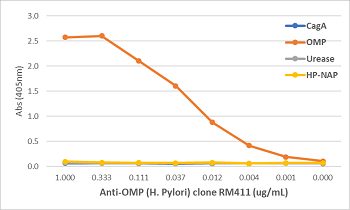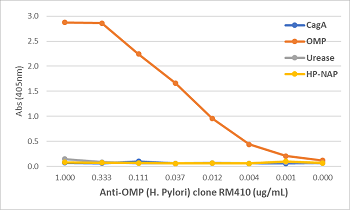
An ELISA of Helicobacter Pylori proteins using Anti-OMP Rabbit Monoclonal Antibody Clone RM410. The plate was coated with 1 ug/mL of CagA, OMP, Urease, or HP-NAP of H. Pylori. A serial dilution of RM410 was used as the primary antibody. An alkaline phosph
anti-OMP Helicobacter pylori, Rabbit Monoclonal (RM411)
REV-31-1297-00
ApplicationsELISA
Product group Antibodies
Overview
- SupplierRevMAb Biosciences
- Product Nameanti-OMP Helicobacter pylori, Rabbit Monoclonal (RM411)
- Delivery Days Customer10
- ApplicationsELISA
- CertificationResearch Use Only
- ClonalityMonoclonal
- Clone IDRM411
- Concentration1 mg/ml
- HostRabbit
- IsotypeIgG
- Scientific DescriptionHelicobacter pylori (H. pylori) is a bacterial class-I carcinogen that specifically colonizes the gastric epithelium of humans as a unique niche, where it can induce inflammatory disorders (e.g. ulceration, chronic gastritis, etc.) and malignant neoplastic diseases (mucosa-associated lymphoid tissue [MALT] lymphoma and gastric cancer). To resist the hostile environment in the stomach, H. pylori has developed highly sophisticated mechanisms to establish life-long infections in the stomach if not therapeutically eradicated. Helicobacter pylori can exist in a number of locations: in the mucus; attached to epithelial cells; or inside of vacuoles in epithelial cells, where it produces adhesins that bind to membrane-associated lipids and carbohydrates to help its adhesion to epithelial cells. Helicobacter pylori contains a hydrogenase enzyme and obtains energy by oxidizing molecular hydrogen produced by other intestinal bacteria. It also excretes urease in order to convert urea into ammonia and bicarbonate which neutralizes the acidic environment of the stomach. Helicobacter pylori OMPs (outer membrane proteins) are involved in Helicobacter pylori adhesion and can cause signal transduction events in host cells. HP-NAP acts as a chemoattractant for nrutrophils, which produce oxygen radicals, cytokines and chemokines, crucial in driving the Th1 inflammation in H. pylori infection. - Recombinant Antibody. This antibody reacts to outer membrane protein of Helicobacter pylori. Applications: ELISA. Source: Rabbit. Liquid. 50% Glycerol/PBS with 1% BSA and 0.09% sodium azide. Helicobacter pylori (H. pylori) is a bacterial class-I carcinogen that specifically colonizes the gastric epithelium of humans as a unique niche, where it can induce inflammatory disorders (e.g. ulceration, chronic gastritis, etc.) and malignant neoplastic diseases (mucosa-associated lymphoid tissue [MALT] lymphoma and gastric cancer). To resist the hostile environment in the stomach, H. pylori has developed highly sophisticated mechanisms to establish life-long infections in the stomach if not therapeutically eradicated. Helicobacter pylori can exist in a number of locations: in the mucus; attached to epithelial cells; or inside of vacuoles in epithelial cells, where it produces adhesins that bind to membrane-associated lipids and carbohydrates to help its adhesion to epithelial cells. Helicobacter pylori contains a hydrogenase enzyme and obtains energy by oxidizing molecular hydrogen produced by other intestinal bacteria. It also excretes urease in order to convert urea into ammonia and bicarbonate which neutralizes the acidic environment of the stomach. Helicobacter pylori OMPs (outer membrane proteins) are involved in Helicobacter pylori adhesion and can cause signal transduction events in host cells. HP-NAP acts as a chemoattractant for nrutrophils, which produce oxygen radicals, cytokines and chemokines, crucial in driving the Th1 inflammation in H. pylori infection.
- Storage Instruction-20°C
- UNSPSC12352203

